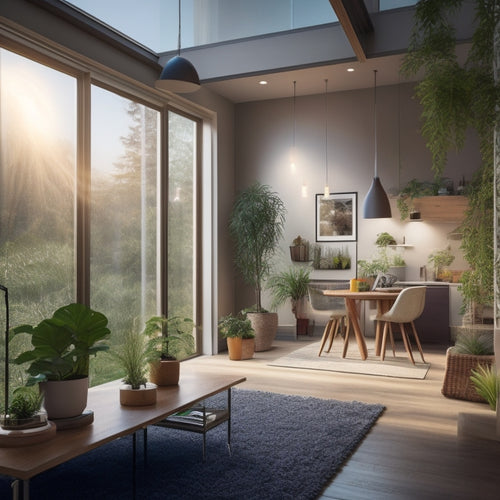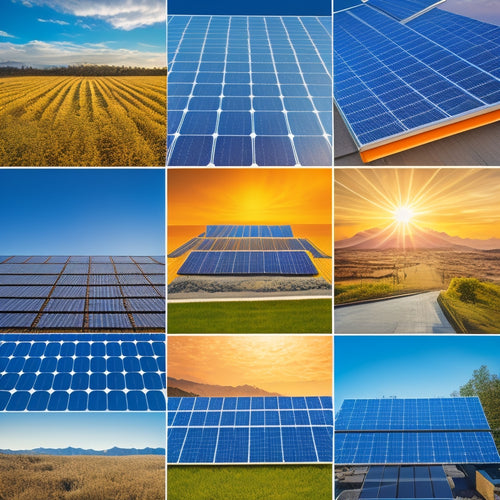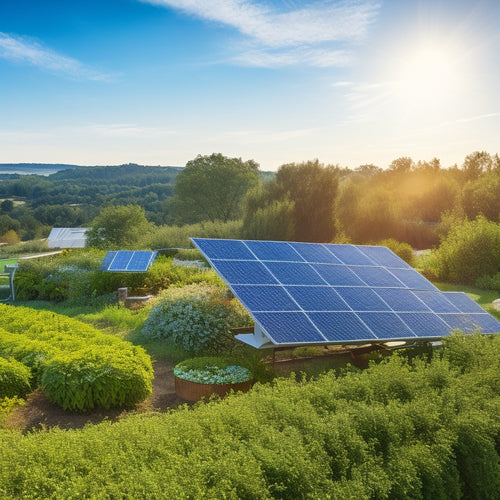
Setting Up a Solar System for Your Home in 5 Steps
Share
You'll need to calculate your energy consumption, choosing the right solar panel type to match your needs and budget. Next, identify the ideal installation location on your roof, considering orientation, shading, and condition. Then, plan for energy storage by determining your battery capacity and inverter efficiency. After that, install and connect your system, acquiring necessary permits and following safety guidelines. By following these 5 steps, you'll be well on your way to utilizing the sun's power, and taking the next step will reveal the finer details to maximize your solar system's efficiency.
Key Takeaways
- Assess your energy needs by calculating average daily usage in kWh to determine the right solar system size for your home.
- Choose the right solar panel type based on efficiency, cost, and durability, considering available roof space and energy requirements.
- Select an optimal installation location with minimal shading, ideal roof orientation, and a suitable roof condition to maximize energy production.
- Plan for energy storage by determining battery capacity needs, selecting an efficient inverter, and balancing backup power with system costs.
- Install and connect the system safely, following local building codes, acquiring necessary permits, and considering professional help if needed.
Assess Your Energy Needs
You'll need to ascertain how much energy your home consumes to size your solar system accurately. This involves calculating your energy consumption, which varies depending on factors like the size of your home, the number of occupants, and your energy usage habits.
Review your past utility bills to get an idea of your average daily energy consumption in kilowatt-hours (kWh). You can also use online energy consumption calculators to estimate your energy needs.
Knowing your energy consumption will help you determine the size of the solar system you need. A correctly sized system will guarantee you maximize your energy production and take full advantage of solar incentives.
These incentives can greatly reduce the cost of installing a solar system, making it a more affordable and attractive option. By accurately evaluating your energy needs, you'll be able to design a solar system that meets your energy requirements and helps you achieve your goal of utilizing renewable energy.
Choose Solar Panel Type
When selecting the right solar panel type for your home, consider the trade-offs between efficiency, cost, and durability.
You'll need to weigh the pros and cons of each option to determine which one best fits your energy needs and budget.
Monocrystalline silicon panels, for instance, offer high efficiency rates (up to 22%) and longer lifespans (up to 30 years).
They're ideal for homes with limited roof space, as they can generate more power per panel. However, they're also the most expensive option.
On the other hand, thin film panels are cheaper and more flexible, making them suitable for curved or irregular surfaces.
However, they've lower efficiency rates (around 7-14%) and shorter lifespans (up to 20 years).
They're also more prone to degradation, which can reduce their energy output over time.
Ultimately, you'll need to balance your energy requirements with your budget and available roof space.
Select Installation Location
Having chosen the right solar panel type for your home, it's now time to contemplate where to install them. The installation location greatly impacts the system's performance, so it's crucial to get it right. You'll want to identify the best location on your roof with the most favorable roof orientation to maximize energy production.
| Roof Orientation | Energy Production | Ideal Installation |
|---|---|---|
| South-facing | High | Ideal for maximum energy production |
| West-facing | Medium | Suitable for afternoon energy production |
| East-facing | Low | Not recommended, consider alternative locations |
Conduct a shading analysis to identify any obstacles that might cast shadows on your solar panels, such as trees, chimneys, or vents. This will help you determine the best layout for your system. Consider the age and condition of your roof, as well. If it's old or damaged, you may need to replace it before installing solar panels. By carefully selecting the installation location, you'll be able to generate the most power from your solar system.
Plan for Energy Storage
Now that you've optimized your solar panel installation location, it's essential to think about how you'll store the excess energy generated by your system. This is where energy storage comes in - a vital component of your solar setup.
You'll need to determine your energy storage requirements based on your daily energy usage and the amount of energy your solar panels produce.
Consider the battery capacity you'll need to store excess energy generated during the day for use at night or during power outages. A higher battery capacity will provide more backup power, but it also increases the overall cost of your system.
Additionally, you'll need to select an inverter that efficiently converts DC power from your solar panels to AC power for your home. Look for an inverter with high efficiency ratings to minimize energy losses.
Install and Connect System
Your toolbox is about to get a workout as you commence on the most hands-on part of setting up your solar system: installing and connecting the components. This is where all your planning and preparation come together. Make certain you have all the necessary installation permits before you begin.
Start by installing the mounting system, followed by the solar panels themselves. Then, connect the panels to the inverter, which converts DC power to AC power usable in your home.
Don't forget to:
- Ground the system to protect against electrical shock
- Connect the inverter to your electrical panel
- Install a net meter to track your energy production and feed excess back into the grid
Remember to follow all safety guidelines and local building codes during the installation process.
If you're not comfortable with heights or electrical work, consider hiring a professional to guarantee a safe and successful installation.
With your system components installed and connected, you're one step away from utilizing the power of the sun.
Frequently Asked Questions
How Long Does It Take to Install a Solar System for My Home?
You'll typically spend 1-3 days on installation, depending on your solar system type and complexity, with the installation timeline varying from a few hours for a simple roof-mounted system to several weeks for a more intricate ground-mounted setup.
Will I Still Have Power During a Blackout With Solar Energy?
You'll maintain power during blackouts with solar energy if you've invested in solar battery storage, ensuring grid independence and a reliable supply of electricity when you need it most.
Can I Sell Excess Energy Back to the Grid?
As you capture the sun's golden rays, you'll likely generate more power than you need, and with net metering benefits, you'll reap energy credits for the excess, allowing you to sell it back to the grid and offset your future energy bills.
Are Solar Panels Affected by Pollution or Dirt Buildup?
You'll notice a decrease in solar panel efficiency if dirt accumulation isn't addressed; regular cleaning is essential to maintain peak performance, as even a thin layer of grime can reduce energy output by up to 25%.
Do Solar Panels Require Regular Maintenance or Repairs?
You're on the ball, getting down to brass tacks about solar panel maintenance! The good news is that solar panels are built to last, with minimal upkeep needed to guarantee peak performance and longevity, keeping maintenance costs low and your energy bills even lower.
Conclusion
You've made it! You've set up a solar system for your home in 5 steps. Now, you're ready to utilize the power of the sun and start saving on your energy bills. Curiously, did you know that a typical residential solar system can save up to $500 per year on electricity costs? With your new solar system, you're not only reducing your carbon footprint but also padding your wallet. Enjoy the benefits of renewable energy and watch your savings grow over time.
Related Posts
-

Energy-Efficient Lighting Solutions for Sustainable Buildings
For sustainable buildings, energy-efficient lighting solutions, like LEDs, offer multiple benefits. These bulbs last ...
-

Comparative Analysis of Top Solar Brands
To conduct a comparative analysis of top solar brands, focus on key metrics like durability, energy efficiency, and s...
-

Green Energy Alternatives for Independent Living
To enhance your independent living, consider green energy alternatives like solar panels and wind turbines. These opt...


